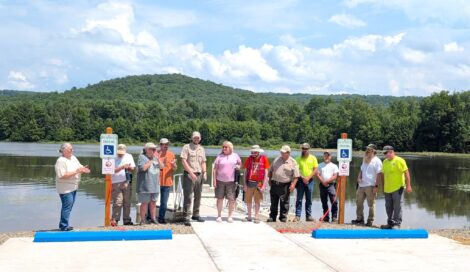Blood, sweat & nickel
Former Dorcon worker looks back on pennstock job
- Warren County Observer photo A day after Dorcon opened its doors in Warren, Dorr-Oliver Construction Company Vice-President W. J. Fox (left) is welcomed by Warren Mayor Arthur Langdon and Dorcon President Alex Fino. Dorcon won the contract to make penstock — steel pipe — for the transmission of water to and from the Seneca Pumped Storage Station upper reservoir. At right, Dorcon workers Chester Forsburg and H.S. Smith assemble a gas holder for a sewage disposal system. The reservoir penstock would have been smaller than the tank in the photo.
- Photo courtesy of Warren County Historical Society An illustration shows the plans for the Seneca Pumped Storage Generating Station and Kinzua Dam.
- Photo courtesy of Warren County Historical Society The area of the Seneca Pumped Storage Generating Station’s upper reservoir is being cleared in this photo from the June 14, 1966, edition of the Warren Times Mirror and Observer.
- Photo courtesy of Warren County Historical Society A May 3, 1967, photo from the Warren Times Mirror and Observer shows a special tractor is lowered into the vertical shaft dug for the upper reservoir at Kinzua Dam. Nickel steel penstock crafted at Dorcon in Warren was placed in that shaft to transmit water to and from the reservoir.
- Photo courtesy of Warren County Historical Society A May 3, 1967, photo from the Warren Times Mirror and Observer shows five men being lowered into the vertical shaft dug for the upper reservoir at Kinzua Dam. Nickel steel penstock crafted at Dorcon in Warren was placed in that shaft to transmit water to and from the reservoir.

Warren County Observer photo A day after Dorcon opened its doors in Warren, Dorr-Oliver Construction Company Vice-President W. J. Fox (left) is welcomed by Warren Mayor Arthur Langdon and Dorcon President Alex Fino. Dorcon won the contract to make penstock — steel pipe — for the transmission of water to and from the Seneca Pumped Storage Station upper reservoir. At right, Dorcon workers Chester Forsburg and H.S. Smith assemble a gas holder for a sewage disposal system. The reservoir penstock would have been smaller than the tank in the photo.
Bob Larson can put on his resume that he took part in the construction of the power generating facility at Kinzua Dam.
But he never worked on the site.
The construction of the dam and its associated elements took place in a number of locations.
Larson was a laborer-helper at Dorcon in the early 1960s.
One of his jobs was to work on the creation of steel tubes that are still in use today.

Photo courtesy of Warren County Historical Society An illustration shows the plans for the Seneca Pumped Storage Generating Station and Kinzua Dam.
The Seneca Pumped Storage Generating Station — the upper reservoir — stores water about 800 feet above the Allegheny River and the generating plant on its banks.
The water is pumped up there when power is cheap. It is then released and falls back down, through a huge, metal pipe, to generate power when it is most needed. That pipe is called a penstock.
Larson helped create that penstock.
The Dorr-Oliver Construction Company expanded and opened Dorcon in Warren in 1961.
Larson said he was the seventh person hired to work in the shop.

Photo courtesy of Warren County Historical Society The area of the Seneca Pumped Storage Generating Station’s upper reservoir is being cleared in this photo from the June 14, 1966, edition of the Warren Times Mirror and Observer.
Back then, Dorcon manufactured “facilities for sewage disposal plants and the petroleum and petro-chemical industries,” according to the Oct. 18, 1961, edition of the Warren County Observer.
The construction of the upper reservoir required penstock able to be installed underground and move water without rusting.
“Dorcon got the contract to manufacture that penstock,” Larson said.
In this case, the material was a nickel alloy steel. “It makes it very resistant to any rust,” he said. That was critical to the project. But, that didn’t make the workers’ jobs any easier.
“It’s very strong and it’s very difficult to shape,” Larson said.

Photo courtesy of Warren County Historical Society A May 3, 1967, photo from the Warren Times Mirror and Observer shows a special tractor is lowered into the vertical shaft dug for the upper reservoir at Kinzua Dam. Nickel steel penstock crafted at Dorcon in Warren was placed in that shaft to transmit water to and from the reservoir.
The company did not pour the steel.
“It’d come in in flat sheets,” Larson said.
Those sheets were about half-an-inch thick, eight feet wide, and 25 feet long. They couldn’t be any wider and still be shipped on trucks.
The sheets were put through rollers set in a pyramid shape that would turn them into open tubes eight feet long and more than eight feet in diameter.
“I’ve stood up inside of them,” Larson said.

Photo courtesy of Warren County Historical Society A May 3, 1967, photo from the Warren Times Mirror and Observer shows five men being lowered into the vertical shaft dug for the upper reservoir at Kinzua Dam. Nickel steel penstock crafted at Dorcon in Warren was placed in that shaft to transmit water to and from the reservoir.
The tubes had to be welded. Due to another property of the nickel alloy, that work had to be done by experienced welders.
The ends of the steel were beveled where they came together, creating a valley. In stick welding, electricity melts the stick — made of the same material as whatever is being worked on — and a portion of the material to be welded. The molten metal from both sources fills the gap, cools, and hardens, creating a strong connection all of the same material.
“On normal steel, it would melt and flow right into that puddle,” Larson said. “The nickel alloy would become magnetic.”
Watching even an experienced welder try to work with that material could be entertaining. Thanks to the magnetism, the stick would disobey the welder and the molten metal would disobey the rules of gravity.
“You wanted (the stick) over here and it would jump around,” Larson said. “You had this drop of molten steel and you wanted it to go here…”
Each section of tube was welded — inside and out — at the shop. But, welding about 100 eight-foot lengths together had to take place on site.
“They would go out in the field, stack them, and weld them,” Larson said.
Larson had to be satisfied with working on penstock that was used at Kinzua Dam.
Initially, he had hoped to be able to get a summer job at the site.
But, despite being told there were openings and making repeat trips to the unemployment office asking for help getting that work, Larson never got in. “I was frustrated,” he said. “I wanted that on my resume.”









